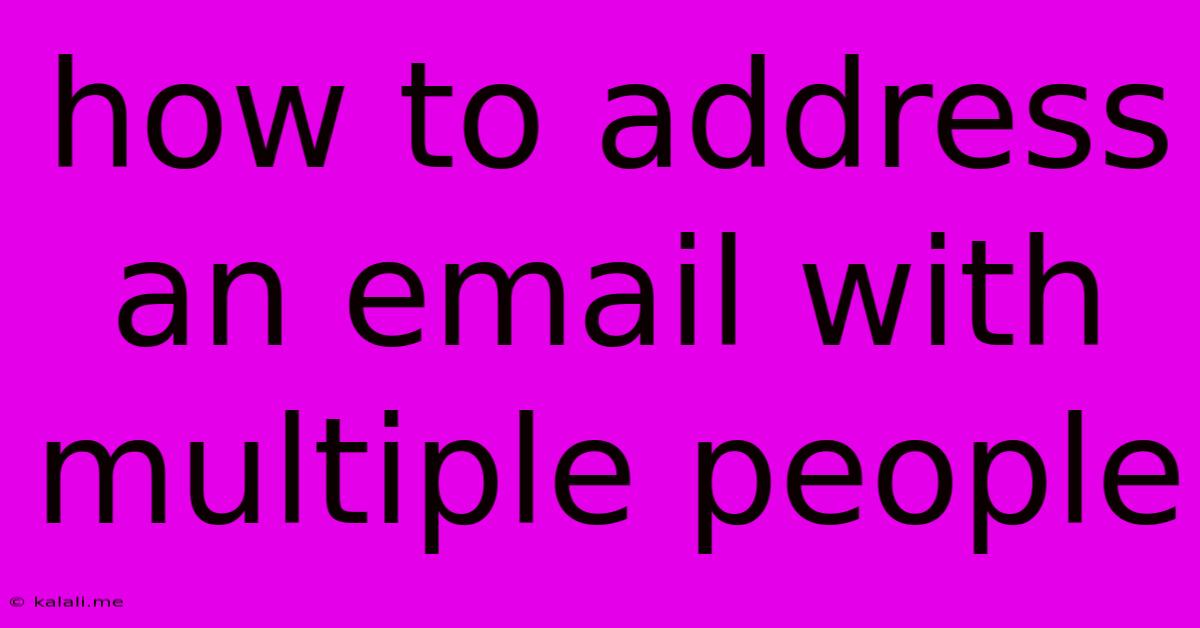How To Address An Email With Multiple People
Kalali
May 22, 2025 · 3 min read

Table of Contents
How to Address an Email with Multiple People: A Guide to Professional Correspondence
Addressing an email with multiple recipients requires a delicate balance of professionalism and clarity. Getting it wrong can lead to confusion, missed information, and even offend your recipients. This guide provides a comprehensive approach to ensure your emails are both effective and courteous, regardless of the number of recipients. Learn the best practices for addressing emails to colleagues, clients, superiors, and various other groups.
Choosing the Right Salutation: The Foundation of a Professional Email
The way you address your email significantly impacts the overall tone and professionalism. The choice depends largely on your relationship with the recipients and the context of the email.
Addressing Individuals You Know Well:
-
Informal (e.g., colleagues, close friends): If you have a close working relationship, a casual greeting like "Hi team," or "Hey everyone," can be appropriate. However, always consider the overall tone of your email and your company culture.
-
Semi-formal (e.g., acquaintances, colleagues in other departments): A slightly more formal greeting like "Hello [names]," or "Hi [names]," strikes a balance between friendliness and professionalism.
Addressing Individuals You Don't Know Well:
- Formal (e.g., clients, superiors, external contacts): Using "Dear [names]," is the most appropriate choice for formal situations. If you have a large number of recipients, you might consider using "Dear team," or "Dear colleagues," depending on the context. Avoid overly casual greetings in these situations.
Handling Multiple Recipients with Varying Levels of Familiarity:
This is where things get trickier. When addressing individuals with different levels of familiarity, err on the side of formality. Using "Dear [names]," is the safest option, ensuring everyone feels respected. Avoid using overly casual greetings that might exclude or offend some recipients.
Utilizing the "To," "Cc," and "Bcc" Fields Effectively
Understanding the functions of these fields is crucial for efficient and professional communication.
-
"To": Use this field for primary recipients who need to act upon or respond to the email.
-
"Cc" (Carbon Copy): Use "Cc" to keep people informed without requiring them to respond. This is ideal for keeping stakeholders updated or for creating a record of communication.
-
"Bcc" (Blind Carbon Copy): This field is for keeping someone informed without revealing their email address to other recipients. Use it cautiously and transparently – always ensure the recipient knows they are included in the "Bcc." It's often best avoided if possible, prioritizing transparency.
Crafting the Body of Your Email: Inclusivity and Clarity
-
Use Inclusive Language: Avoid using gendered pronouns or language that might exclude anyone. Phrase your sentences inclusively.
-
Address Everyone Directly: If possible, address each person individually in the body of the email, especially if the email requires individual actions.
-
Personalize Where Appropriate: When possible, personalize your message to each individual recipient to make the communication more meaningful and engaging.
-
Clear Subject Line: Ensure your subject line concisely reflects the email's content. A clear and informative subject line helps recipients prioritize their inbox effectively.
Example Email Scenarios:
-
Scenario 1 (Informal): "Hi team, quick update on the project…" (Suitable for a small, close-knit team).
-
Scenario 2 (Formal): "Dear Mr. Smith, Ms. Jones, and Dr. Lee, thank you for your time…" (Suitable for a formal communication with multiple external stakeholders).
-
Scenario 3 (Mixed): "Dear Team, and Mr. Johnson, we're pleased to announce…" (Suitable for a team update which also includes an external contact).
By carefully considering these factors, you can confidently and professionally address emails with multiple people, ensuring clear, effective, and respectful communication. Remember, choosing the right approach depends heavily on context and relationship. Prioritize clarity and respect, and you'll avoid common email etiquette pitfalls.
Latest Posts
Latest Posts
-
How To Stop Squeaky Windows On Car
May 22, 2025
-
How To Move A Washing Machine By Yourself
May 22, 2025
-
Calculate The Area Of The Shaded Section Of This Shape
May 22, 2025
-
Who Can Access My Bank Account Without My Permission
May 22, 2025
-
How To Find What Is Tripping My Circuit Breaker
May 22, 2025
Related Post
Thank you for visiting our website which covers about How To Address An Email With Multiple People . We hope the information provided has been useful to you. Feel free to contact us if you have any questions or need further assistance. See you next time and don't miss to bookmark.